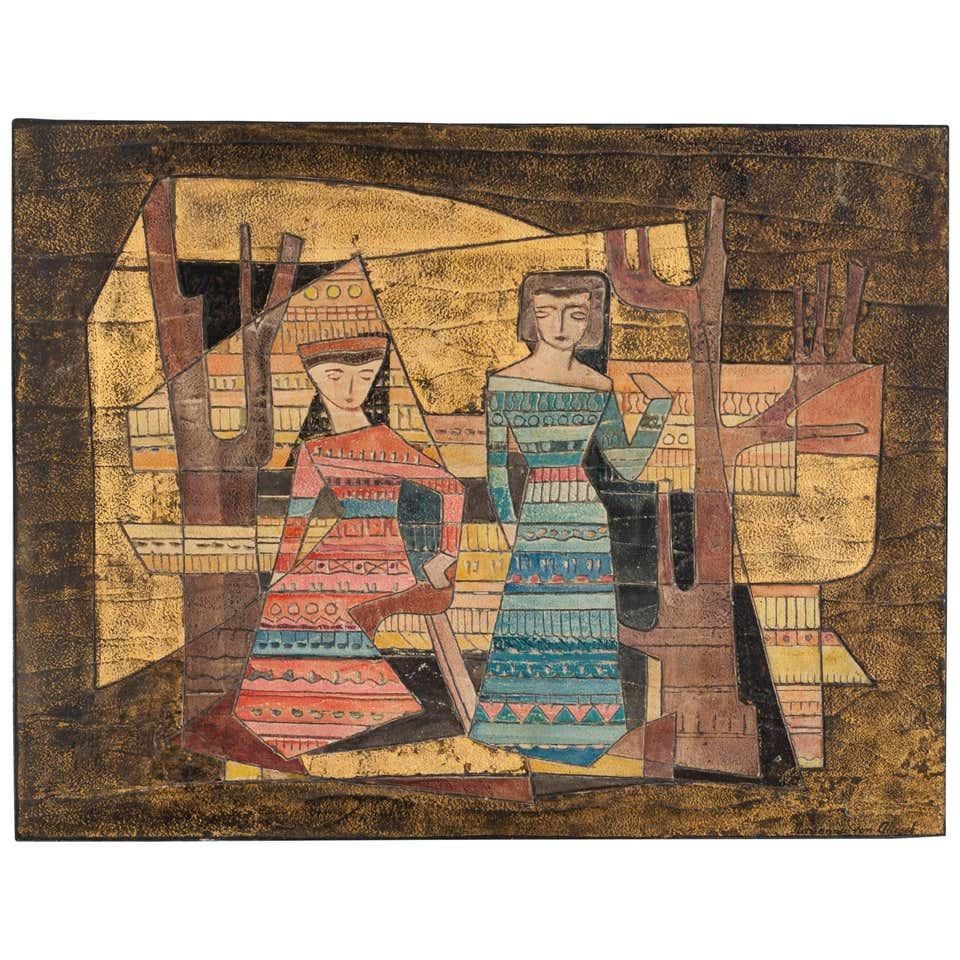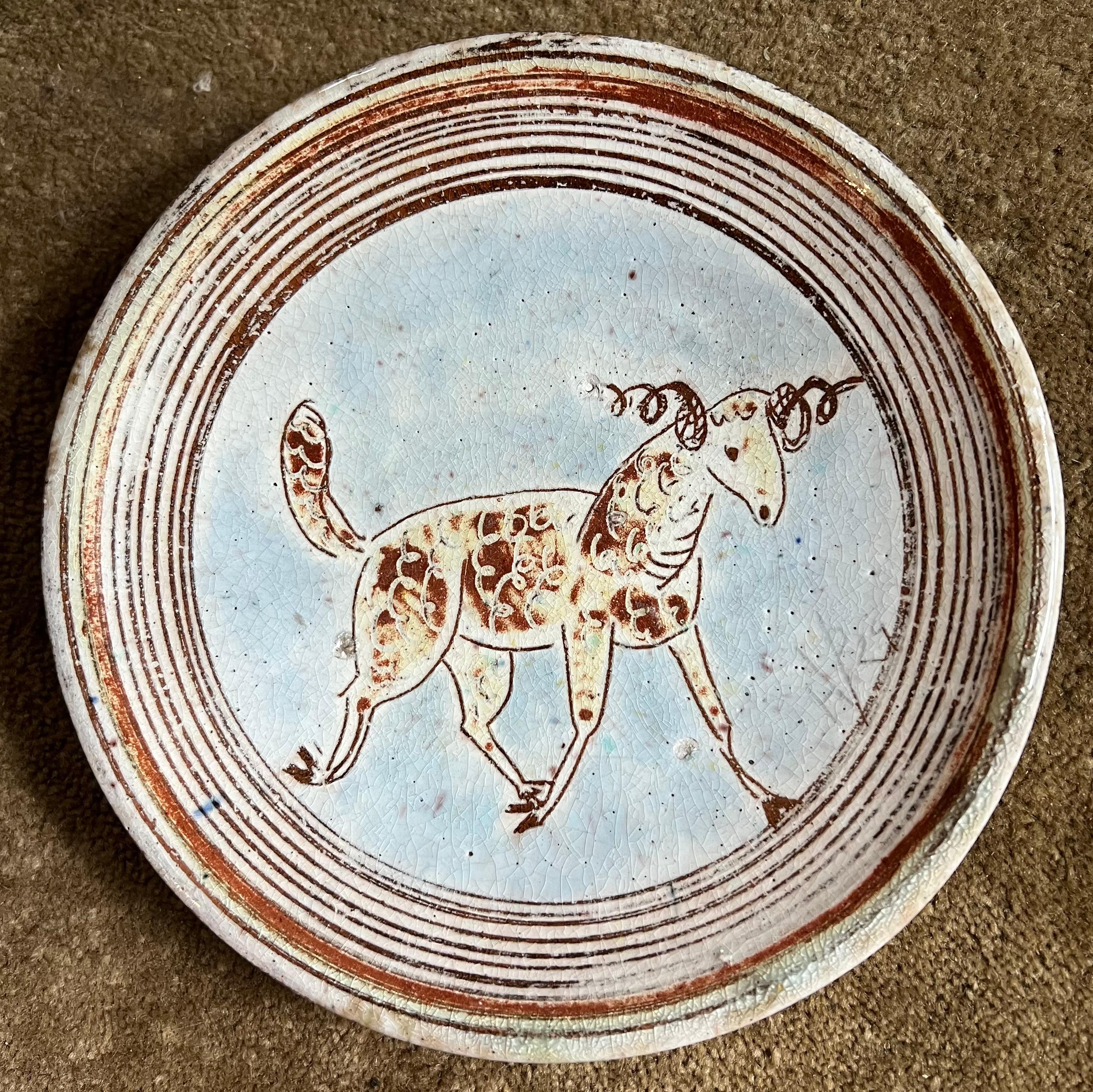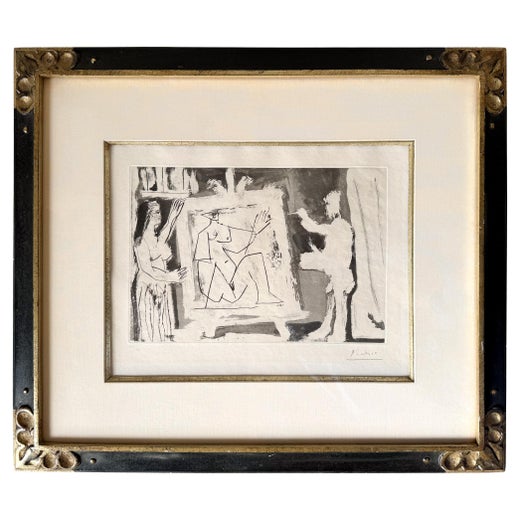Pablo PicassoSujet Poisson (A.R. 139). Ceramic Stamped Madoura Plein Feu, Edition Picasso1952
1952
About the Item
- Creator:Pablo Picasso (1881-1973, Spanish)
- Creation Year:1952
- Dimensions:Height: 5.71 in (14.5 cm)Width: 8.47 in (21.5 cm)
- Medium:
- Movement & Style:
- Period:
- Condition:
- Gallery Location:Madrid, ES
- Reference Number:1stDibs: LU1281110341212
Pablo Picasso
One of the most prolific and revolutionary artists the world has ever seen, Pablo Picasso had a tremendous impact on the development of 20th-century modern art. Although he is best known for his association with the Cubist movement, which he founded with Georges Braque, Picasso’s influence extends to Surrealism, neoclassicism and Expressionism.
“Every act of creation is, first of all, an act of destruction,” the Spanish artist proclaimed. In Picasso's Cubist paintings, he emphasizes the two-dimensionality of the canvas, breaking with conventions regarding perspective, foreshortening and proportion. Picasso was inspired by Iberian and African tribal art. One of his most famous pre-Cubist works is Les Demoiselles d’Avignon (1907), a painting considered immoral and shocking at the time for its depiction of nude women whose faces resemble Iberian tribal masks.
Picasso made many portraits in this style, most often of the women in his life, their expressively colored faces composed of geometric shards of surface planes. In Woman in a Hat (Olga), 1935, he painted his first wife as an assemblage of abstract forms, leaving the viewer to decipher the subject through the contrasting colors and shapes. Picasso was a tireless artist, creating more than 20,000 paintings, drawings, prints, ceramics and sculptures. Tracing his life’s work reveals the progression of modern art, on which he had an unparalleled influence.
Browse an expansive collection of Pablo Picasso's art on 1stDibs.
- ShippingRetrieving quote...Ships From: Madrid, Spain
- Return PolicyA return for this item may be initiated within 14 days of delivery.
- Pablo Picasso, Trois poissons sur fond gris (A.R. 396)By Pablo PicassoLocated in Madrid, ESPABLO PICASSO (1881-1973) Trois poissons sur fond gris (A.R. 396) stamped, marked and numbered 'Edition Picasso / Madoura Plein Feu / N 106 / Edition Picasso / 80/175' (underneath) t...Category
1950s Modern More Art
MaterialsTerracotta
- Chope Visage (AR 432), 1959. Ceramic Stamped Madoura Plein Feu, Edition PicassoBy Pablo PicassoLocated in Madrid, ESPABLO PICASSO Spanish, 1881-1973 CHOPE VISAGE (A.R. 432) stamped and marked 'Edition Picasso / Madoura Plein Feu / Edition Picasso / 268/300 / Madoura' (...Category
1950s Modern More Art
MaterialsCeramic
- “Le Barbu” (A.R. 217). Ceramic Stamped Madoura Plein Feu, Edition PicassoBy Pablo PicassoLocated in Madrid, ESPABLO PICASSO (1881-1973) LE BARBU (A.R. 217) stamped and marked 'Edition Picasso/Madoura Plein Feu/Edition Picasso/Madoura' (underneath) white earthenware ceramic pitcher, partially engraved, with colored engobe and glaze Height: 12¾ in. (31.5 cm.) Conceived in 1953 and executed in an edition of 500 LITERATURE: - Ramié, Alain: Picasso, Catalogue of the Edited...Category
1950s Modern More Art
MaterialsCeramic
- Pablo Picasso, Hibou rouge sur fond noir (A.R. 399)By Pablo PicassoLocated in Madrid, ESPABLO PICASSO (1881-1973) Hibou rouge sur fond noir (A.R. 399) stamped, marked and numbered 'Madoura Plein Feu / Edition Picasso / N 103 / Edition Picasso / 1/150 / Madoura' (underne...Category
1950s Modern More Art
MaterialsTerracotta
- Sujet Colombe (A.R. 435). Ceramic Stamped Madoura Plein Feu, Edition PicassoBy Pablo PicassoLocated in Madrid, ESPablo Picasso (1881-1973) Sujet colombe (A.R. 435) stamped, marked and numbered 'Edition Picasso / Madoura Plein Feu / Edition Picasso / 188/500 / Madoura' (...Category
1950s Modern More Art
MaterialsCeramic
- Visage de Femme (A.R. 192). Ceramic Stamped Madoura Plein Feu, Edition PicassoBy Pablo PicassoLocated in Madrid, ESPABLO PICASSO Spanish, 1881-1973 VISAGE DE FEMME (A.R. 192) stamped, marked and numbered 'Edition Picasso / Madoura Plein Feu / Edition Picasso / 154/200 / Madoura' (underneath) whi...Category
1950s Modern More Art
MaterialsCeramic
- Robert Fournier Bottle Stoneware 1960-1965 White Brown Crusty Textured GlazeLocated in Eversholt, BedfordshireRobert Fournier (1915-2008), stoneware, tall flattened, bottle, circa 1960-1965 - This bottle is from the same series as No.2008.658.18 in the Metrop...Category
1960s Modern More Art
MaterialsCeramic
- Alan Wallwork Vessel Vase Pottery Sculpture TOTEM White Brown TerracottaLocated in Eversholt, BedfordshireAlan Wallwork (1931-2019): Organic landscape sculptural vessel, 1960-1965 -Exhibiting the articulated, inventive, organic qualities & tactility of Wallwork’s early oeuvre for which he is best known - This sculptural landscape vessel has been handmade by coiling, slabbing and shaping the clay. The totemic form and pitted and pierced surfaces draw on the abstract landscape and tactility of elements in nature. matte glazes and oxides have been skillfully used to enhance the rich textures of the surfaces and the organic aesthetic. - Wallwork is one of the great individualists in British pottery, developing an archetypal language that echoed some of the wider artistic obsessions of that period, what the art critic Herbert Read called the “postwar ferment” of sculptural activity. - This piece was made during 1960-1965, the time that Wallwork was sharing a studio in Greenwich with Bernard Rooke and comes from a private collection along with a waterscape vase by Rooke and a bottle by Robert Fournier...Category
1960s Modern More Art
MaterialsCeramic
- Marianna Von Allesch Ceramic Wall Hanging Art Mid-Century ModernLocated in Washington, DCRare and wonderful mid-century modern ceramic wall hanging by Marianna von Allesch. Incised design on ceramic panel. Signed lower right corner. Me...Category
1950s Modern More Art
MaterialsCeramic
- Plate with Ram (Untitled)By Henry Varnum PoorLocated in Los Angeles, CA(Note: This work is part of our exhibition Connected by Creativity: WPA Era Works from the Collection of Leata and Edward Beatty Rowan) Glazed and incised ceramic, 8 ½ inches diamet...Category
1920s American Modern More Art
MaterialsCeramic
- Paire Bougeoirs Elephant, Candle Stick, Animal, Ceramic, Lalanne, DesignBy François-Xavier LalanneLocated in Geneva, CHPaire Bougeoirs Elephant, Candle Stick, Animal, Ceramic, Lalanne, Design Paire Bougeoirs Elephant Ed. 80 pcs 1985 Glazed ceramic and copper with original boxes 15 x 15.3 x 6 cm / 5....Category
1980s Modern Figurative Sculptures
MaterialsCeramic
- John Glick Plum Tree Pottery , Stoneware Mug, Deep Earth Tones, GlazedLocated in Detroit, MI“Untitled” ceramic, is an example of the kind of work by which John Glick became so famous. He was seduced by the effects of the reduction kiln, which decreased the levels of oxygen during firing, inducing the flame to pull oxygen out of the clay and glazes changing the colors of the glazes depending on their iron and copper content. In this way he achieved the rich gradients of ochre and umber and variations in stippling and opacity. This piece is signed on the bottom and can be found on page 129, plate #236 in “John Glick: A Legacy in Clay.” John was an American Abstract Expressionist ceramicist born in Detroit, MI. Though open to artistic experimentation, Glick was most influenced by the styles and aesthetics of Asian pottery—an inspiration that shows in his use of decorative patterns and glaze choices. He has said that he is attracted to simplicity, as well as complexity: my work continually reflects my re-examination that these two poles can coexist… or not, in a given series. Glick also took influences from master potters of Japan, notably Shoji Hamada and Kanjrio Kawai, blending their gestural embellishments of simple forms with attitudes of Abstract Expressionism. He was particularly drown to the work of Helen Frankenthaler whose soak-stain style resonated with Glick’s multi-layered glaze surfaces, which juxtaposed veils of atmospheric color with gestural marks and pattern. He spent countless hours developing and making his own tools in order to achieve previously unseen results in his work with clay and glaze. Glick’s “Plum Tree Pottery...Category
Late 20th Century American Modern More Art
MaterialsStoneware, Glaze
Recently Viewed
View AllRead More
Science Uncovers Hidden Truths behind Young Pablo Picasso’s Blue Period
From 1901 to 1904, Picasso limited his palette to bluish hues in producing some of his most famous early works. A new show looks at the recycled materials, hidden underpaintings, surprising influences and bohemian lifestyle that led to their creation.
Who Are the Most Popular Artists on 1stdibs?
Learn the stories of some of the world's most recognizable artworks and their makers.





